Health and Society Assessment: Childhood Obesity and Health Inequity
VerifiedAdded on 2022/12/27
|10
|2539
|51
Report
AI Summary
This report delves into the critical issue of health inequity between Indigenous and non-Indigenous Australians, with a specific focus on childhood obesity. The report begins by identifying the disparities in health outcomes, highlighting the government's shortcomings in addressing the issue and the inadequate understanding of the right to health. It then explores the impact of primary health care interventions, such as pediatric primary care, in addressing childhood obesity and reducing inequity. The report also examines the role of cultural knowledge and sensitivity in health care, illustrating how these factors can influence access to primary health care services. The analysis incorporates cultural knowledge to acknowledge the disparities in health outcomes and the importance of cultural sensitivity in delivering effective health services. The report concludes by emphasizing the need for equitable distribution of resources, culturally appropriate interventions, and a commitment to addressing the social determinants of health to bridge the gap in health outcomes.
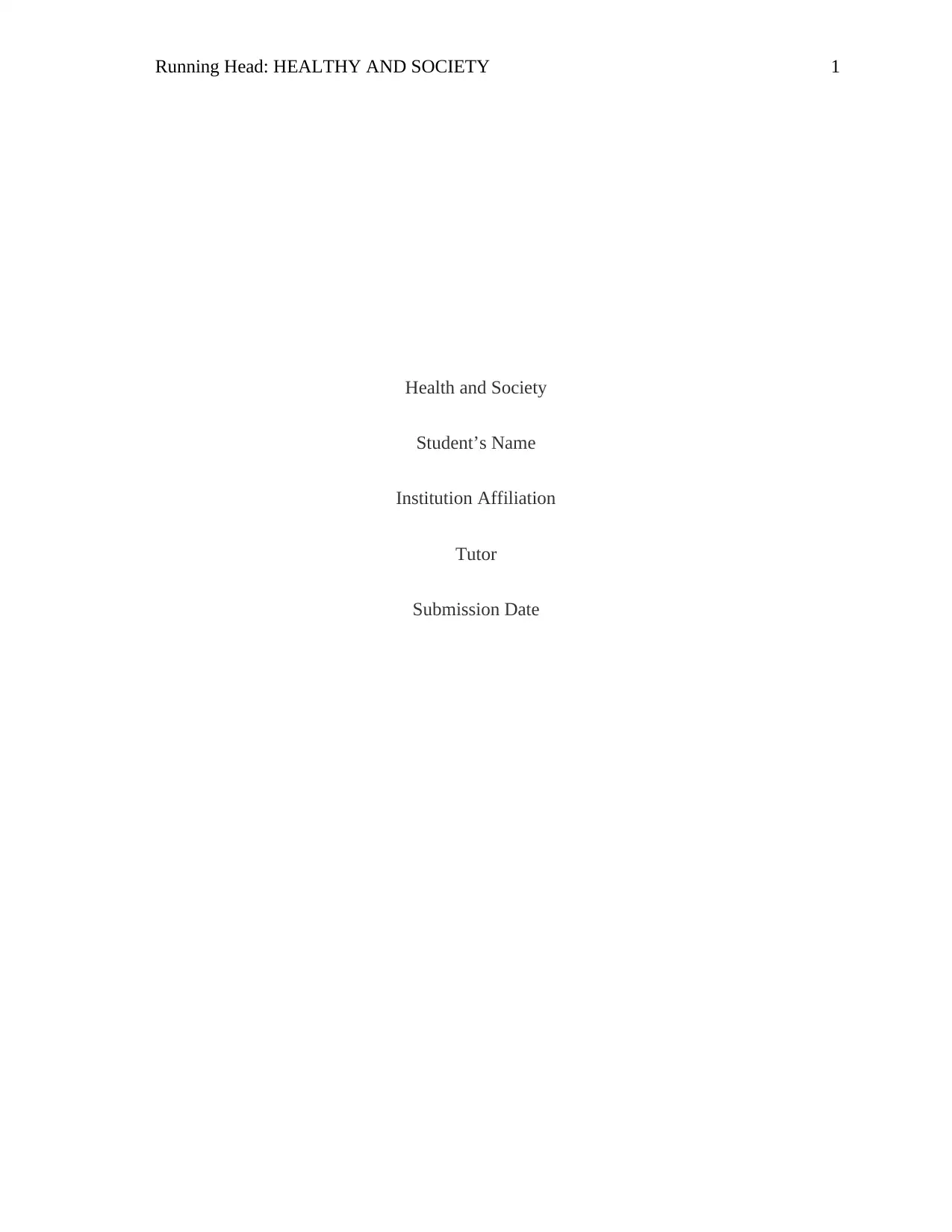
Running Head: HEALTHY AND SOCIETY 1
Health and Society
Student’s Name
Institution Affiliation
Tutor
Submission Date
Health and Society
Student’s Name
Institution Affiliation
Tutor
Submission Date
Paraphrase This Document
Need a fresh take? Get an instant paraphrase of this document with our AI Paraphraser
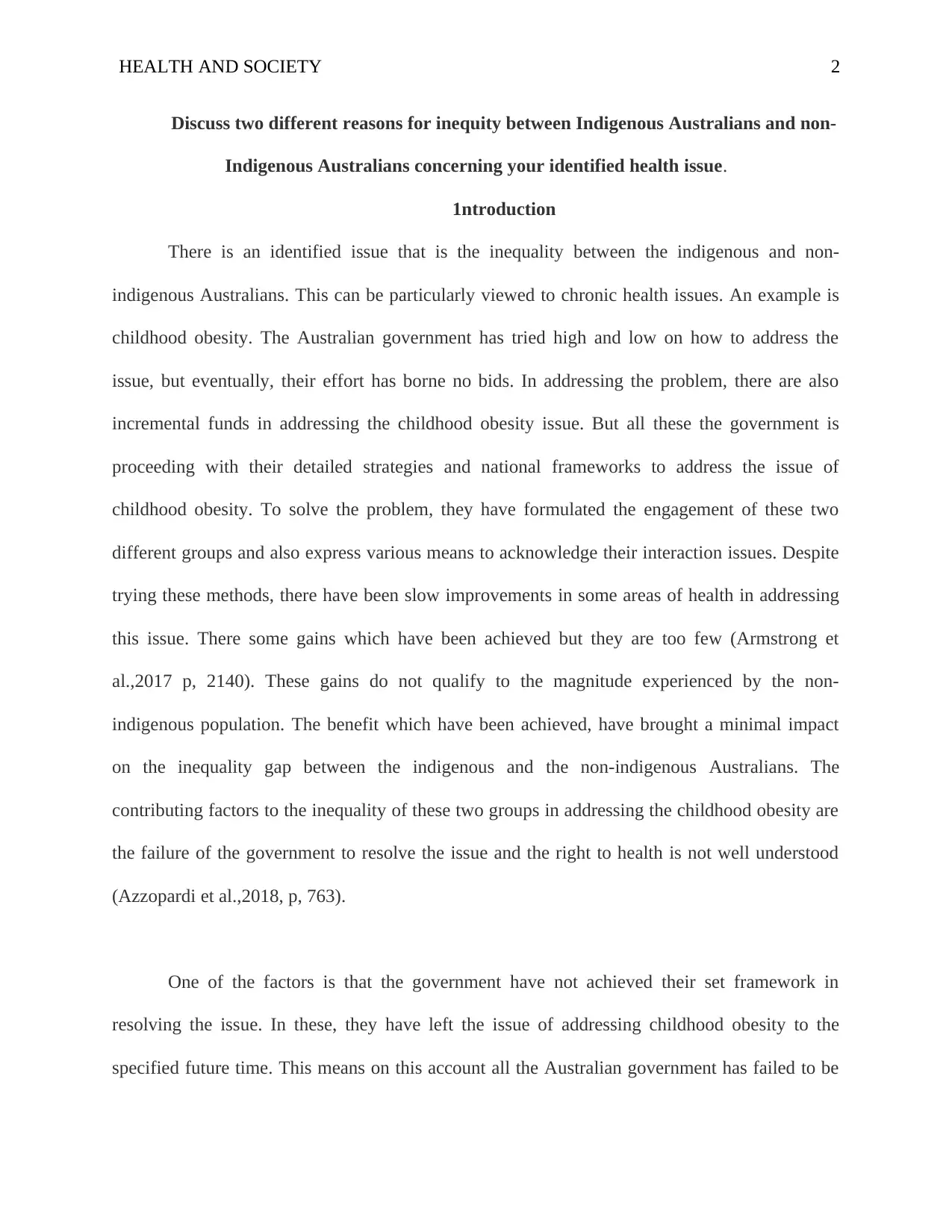
HEALTH AND SOCIETY 2
Discuss two different reasons for inequity between Indigenous Australians and non-
Indigenous Australians concerning your identified health issue.
1ntroduction
There is an identified issue that is the inequality between the indigenous and non-
indigenous Australians. This can be particularly viewed to chronic health issues. An example is
childhood obesity. The Australian government has tried high and low on how to address the
issue, but eventually, their effort has borne no bids. In addressing the problem, there are also
incremental funds in addressing the childhood obesity issue. But all these the government is
proceeding with their detailed strategies and national frameworks to address the issue of
childhood obesity. To solve the problem, they have formulated the engagement of these two
different groups and also express various means to acknowledge their interaction issues. Despite
trying these methods, there have been slow improvements in some areas of health in addressing
this issue. There some gains which have been achieved but they are too few (Armstrong et
al.,2017 p, 2140). These gains do not qualify to the magnitude experienced by the non-
indigenous population. The benefit which have been achieved, have brought a minimal impact
on the inequality gap between the indigenous and the non-indigenous Australians. The
contributing factors to the inequality of these two groups in addressing the childhood obesity are
the failure of the government to resolve the issue and the right to health is not well understood
(Azzopardi et al.,2018, p, 763).
One of the factors is that the government have not achieved their set framework in
resolving the issue. In these, they have left the issue of addressing childhood obesity to the
specified future time. This means on this account all the Australian government has failed to be
Discuss two different reasons for inequity between Indigenous Australians and non-
Indigenous Australians concerning your identified health issue.
1ntroduction
There is an identified issue that is the inequality between the indigenous and non-
indigenous Australians. This can be particularly viewed to chronic health issues. An example is
childhood obesity. The Australian government has tried high and low on how to address the
issue, but eventually, their effort has borne no bids. In addressing the problem, there are also
incremental funds in addressing the childhood obesity issue. But all these the government is
proceeding with their detailed strategies and national frameworks to address the issue of
childhood obesity. To solve the problem, they have formulated the engagement of these two
different groups and also express various means to acknowledge their interaction issues. Despite
trying these methods, there have been slow improvements in some areas of health in addressing
this issue. There some gains which have been achieved but they are too few (Armstrong et
al.,2017 p, 2140). These gains do not qualify to the magnitude experienced by the non-
indigenous population. The benefit which have been achieved, have brought a minimal impact
on the inequality gap between the indigenous and the non-indigenous Australians. The
contributing factors to the inequality of these two groups in addressing the childhood obesity are
the failure of the government to resolve the issue and the right to health is not well understood
(Azzopardi et al.,2018, p, 763).
One of the factors is that the government have not achieved their set framework in
resolving the issue. In these, they have left the issue of addressing childhood obesity to the
specified future time. This means on this account all the Australian government has failed to be
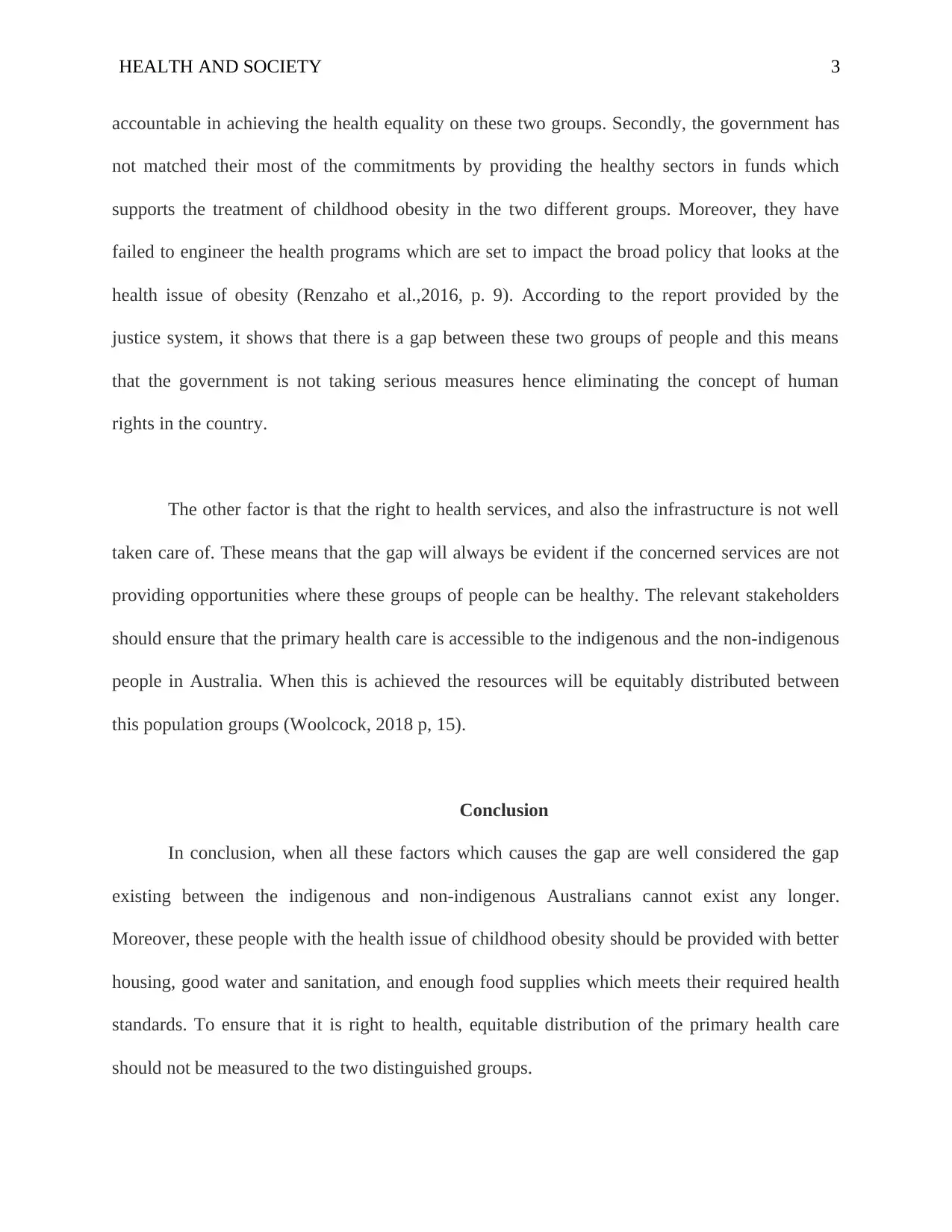
HEALTH AND SOCIETY 3
accountable in achieving the health equality on these two groups. Secondly, the government has
not matched their most of the commitments by providing the healthy sectors in funds which
supports the treatment of childhood obesity in the two different groups. Moreover, they have
failed to engineer the health programs which are set to impact the broad policy that looks at the
health issue of obesity (Renzaho et al.,2016, p. 9). According to the report provided by the
justice system, it shows that there is a gap between these two groups of people and this means
that the government is not taking serious measures hence eliminating the concept of human
rights in the country.
The other factor is that the right to health services, and also the infrastructure is not well
taken care of. These means that the gap will always be evident if the concerned services are not
providing opportunities where these groups of people can be healthy. The relevant stakeholders
should ensure that the primary health care is accessible to the indigenous and the non-indigenous
people in Australia. When this is achieved the resources will be equitably distributed between
this population groups (Woolcock, 2018 p, 15).
Conclusion
In conclusion, when all these factors which causes the gap are well considered the gap
existing between the indigenous and non-indigenous Australians cannot exist any longer.
Moreover, these people with the health issue of childhood obesity should be provided with better
housing, good water and sanitation, and enough food supplies which meets their required health
standards. To ensure that it is right to health, equitable distribution of the primary health care
should not be measured to the two distinguished groups.
accountable in achieving the health equality on these two groups. Secondly, the government has
not matched their most of the commitments by providing the healthy sectors in funds which
supports the treatment of childhood obesity in the two different groups. Moreover, they have
failed to engineer the health programs which are set to impact the broad policy that looks at the
health issue of obesity (Renzaho et al.,2016, p. 9). According to the report provided by the
justice system, it shows that there is a gap between these two groups of people and this means
that the government is not taking serious measures hence eliminating the concept of human
rights in the country.
The other factor is that the right to health services, and also the infrastructure is not well
taken care of. These means that the gap will always be evident if the concerned services are not
providing opportunities where these groups of people can be healthy. The relevant stakeholders
should ensure that the primary health care is accessible to the indigenous and the non-indigenous
people in Australia. When this is achieved the resources will be equitably distributed between
this population groups (Woolcock, 2018 p, 15).
Conclusion
In conclusion, when all these factors which causes the gap are well considered the gap
existing between the indigenous and non-indigenous Australians cannot exist any longer.
Moreover, these people with the health issue of childhood obesity should be provided with better
housing, good water and sanitation, and enough food supplies which meets their required health
standards. To ensure that it is right to health, equitable distribution of the primary health care
should not be measured to the two distinguished groups.
⊘ This is a preview!⊘
Do you want full access?
Subscribe today to unlock all pages.

Trusted by 1+ million students worldwide
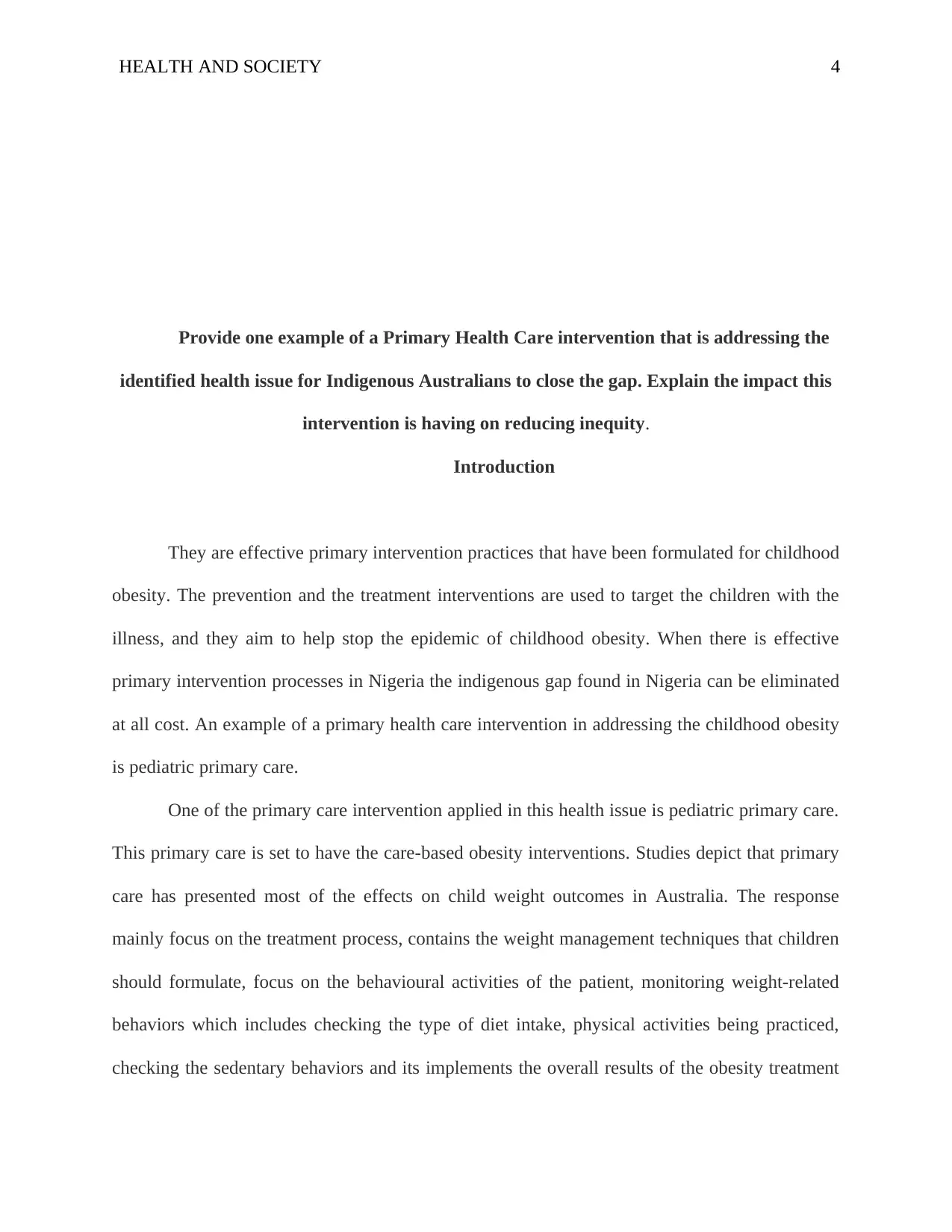
HEALTH AND SOCIETY 4
Provide one example of a Primary Health Care intervention that is addressing the
identified health issue for Indigenous Australians to close the gap. Explain the impact this
intervention is having on reducing inequity.
Introduction
They are effective primary intervention practices that have been formulated for childhood
obesity. The prevention and the treatment interventions are used to target the children with the
illness, and they aim to help stop the epidemic of childhood obesity. When there is effective
primary intervention processes in Nigeria the indigenous gap found in Nigeria can be eliminated
at all cost. An example of a primary health care intervention in addressing the childhood obesity
is pediatric primary care.
One of the primary care intervention applied in this health issue is pediatric primary care.
This primary care is set to have the care-based obesity interventions. Studies depict that primary
care has presented most of the effects on child weight outcomes in Australia. The response
mainly focus on the treatment process, contains the weight management techniques that children
should formulate, focus on the behavioural activities of the patient, monitoring weight-related
behaviors which includes checking the type of diet intake, physical activities being practiced,
checking the sedentary behaviors and its implements the overall results of the obesity treatment
Provide one example of a Primary Health Care intervention that is addressing the
identified health issue for Indigenous Australians to close the gap. Explain the impact this
intervention is having on reducing inequity.
Introduction
They are effective primary intervention practices that have been formulated for childhood
obesity. The prevention and the treatment interventions are used to target the children with the
illness, and they aim to help stop the epidemic of childhood obesity. When there is effective
primary intervention processes in Nigeria the indigenous gap found in Nigeria can be eliminated
at all cost. An example of a primary health care intervention in addressing the childhood obesity
is pediatric primary care.
One of the primary care intervention applied in this health issue is pediatric primary care.
This primary care is set to have the care-based obesity interventions. Studies depict that primary
care has presented most of the effects on child weight outcomes in Australia. The response
mainly focus on the treatment process, contains the weight management techniques that children
should formulate, focus on the behavioural activities of the patient, monitoring weight-related
behaviors which includes checking the type of diet intake, physical activities being practiced,
checking the sedentary behaviors and its implements the overall results of the obesity treatment
Paraphrase This Document
Need a fresh take? Get an instant paraphrase of this document with our AI Paraphraser
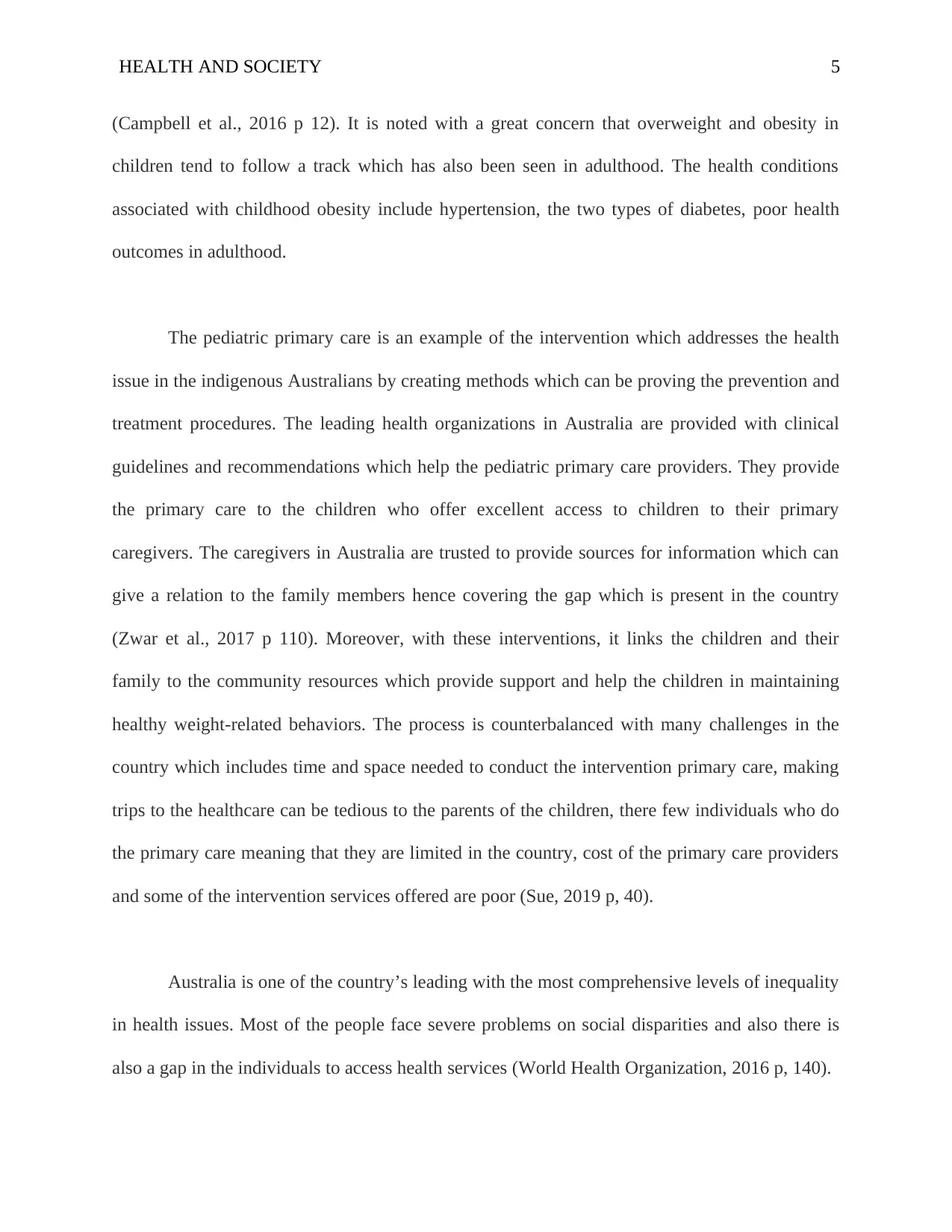
HEALTH AND SOCIETY 5
(Campbell et al., 2016 p 12). It is noted with a great concern that overweight and obesity in
children tend to follow a track which has also been seen in adulthood. The health conditions
associated with childhood obesity include hypertension, the two types of diabetes, poor health
outcomes in adulthood.
The pediatric primary care is an example of the intervention which addresses the health
issue in the indigenous Australians by creating methods which can be proving the prevention and
treatment procedures. The leading health organizations in Australia are provided with clinical
guidelines and recommendations which help the pediatric primary care providers. They provide
the primary care to the children who offer excellent access to children to their primary
caregivers. The caregivers in Australia are trusted to provide sources for information which can
give a relation to the family members hence covering the gap which is present in the country
(Zwar et al., 2017 p 110). Moreover, with these interventions, it links the children and their
family to the community resources which provide support and help the children in maintaining
healthy weight-related behaviors. The process is counterbalanced with many challenges in the
country which includes time and space needed to conduct the intervention primary care, making
trips to the healthcare can be tedious to the parents of the children, there few individuals who do
the primary care meaning that they are limited in the country, cost of the primary care providers
and some of the intervention services offered are poor (Sue, 2019 p, 40).
Australia is one of the country’s leading with the most comprehensive levels of inequality
in health issues. Most of the people face severe problems on social disparities and also there is
also a gap in the individuals to access health services (World Health Organization, 2016 p, 140).
(Campbell et al., 2016 p 12). It is noted with a great concern that overweight and obesity in
children tend to follow a track which has also been seen in adulthood. The health conditions
associated with childhood obesity include hypertension, the two types of diabetes, poor health
outcomes in adulthood.
The pediatric primary care is an example of the intervention which addresses the health
issue in the indigenous Australians by creating methods which can be proving the prevention and
treatment procedures. The leading health organizations in Australia are provided with clinical
guidelines and recommendations which help the pediatric primary care providers. They provide
the primary care to the children who offer excellent access to children to their primary
caregivers. The caregivers in Australia are trusted to provide sources for information which can
give a relation to the family members hence covering the gap which is present in the country
(Zwar et al., 2017 p 110). Moreover, with these interventions, it links the children and their
family to the community resources which provide support and help the children in maintaining
healthy weight-related behaviors. The process is counterbalanced with many challenges in the
country which includes time and space needed to conduct the intervention primary care, making
trips to the healthcare can be tedious to the parents of the children, there few individuals who do
the primary care meaning that they are limited in the country, cost of the primary care providers
and some of the intervention services offered are poor (Sue, 2019 p, 40).
Australia is one of the country’s leading with the most comprehensive levels of inequality
in health issues. Most of the people face severe problems on social disparities and also there is
also a gap in the individuals to access health services (World Health Organization, 2016 p, 140).
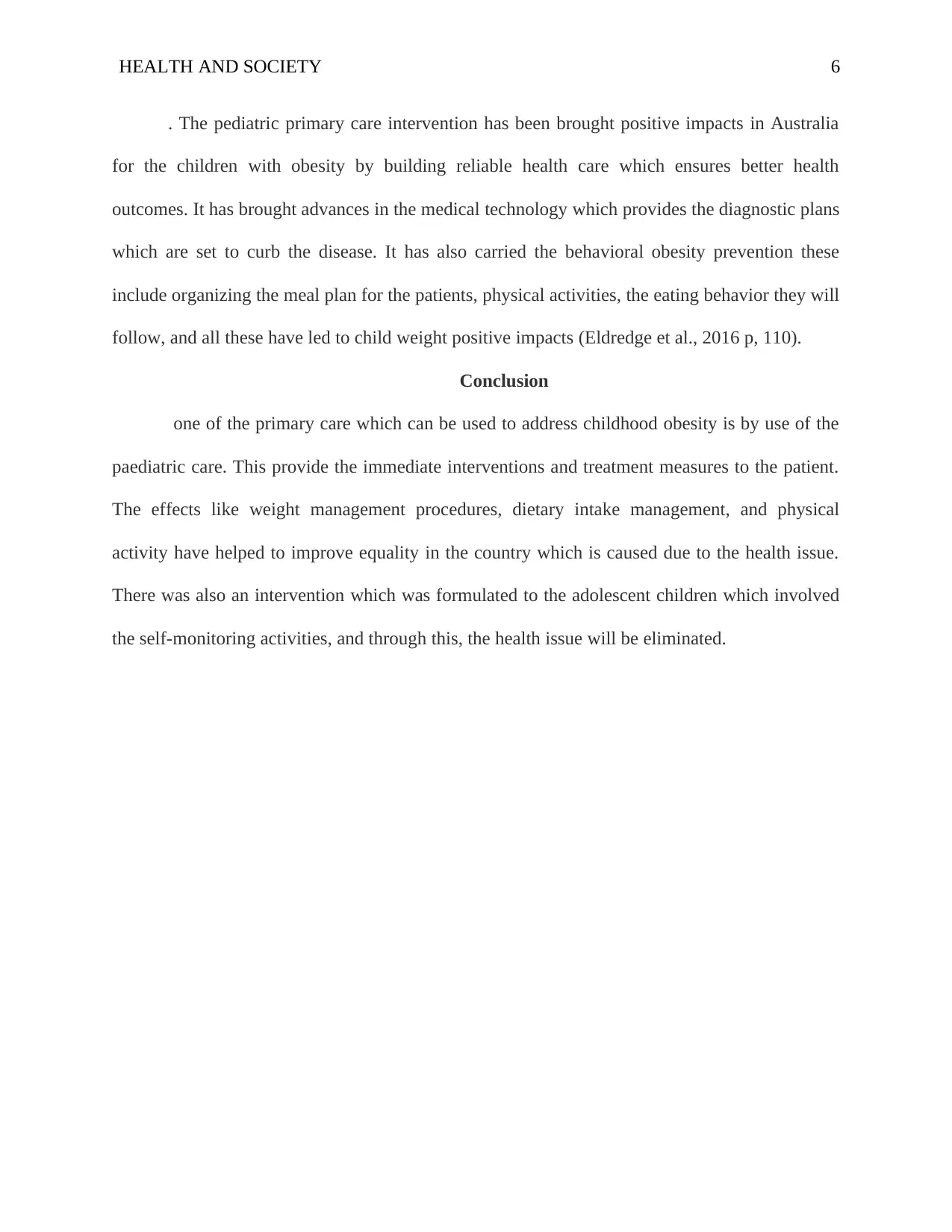
HEALTH AND SOCIETY 6
. The pediatric primary care intervention has been brought positive impacts in Australia
for the children with obesity by building reliable health care which ensures better health
outcomes. It has brought advances in the medical technology which provides the diagnostic plans
which are set to curb the disease. It has also carried the behavioral obesity prevention these
include organizing the meal plan for the patients, physical activities, the eating behavior they will
follow, and all these have led to child weight positive impacts (Eldredge et al., 2016 p, 110).
Conclusion
one of the primary care which can be used to address childhood obesity is by use of the
paediatric care. This provide the immediate interventions and treatment measures to the patient.
The effects like weight management procedures, dietary intake management, and physical
activity have helped to improve equality in the country which is caused due to the health issue.
There was also an intervention which was formulated to the adolescent children which involved
the self-monitoring activities, and through this, the health issue will be eliminated.
. The pediatric primary care intervention has been brought positive impacts in Australia
for the children with obesity by building reliable health care which ensures better health
outcomes. It has brought advances in the medical technology which provides the diagnostic plans
which are set to curb the disease. It has also carried the behavioral obesity prevention these
include organizing the meal plan for the patients, physical activities, the eating behavior they will
follow, and all these have led to child weight positive impacts (Eldredge et al., 2016 p, 110).
Conclusion
one of the primary care which can be used to address childhood obesity is by use of the
paediatric care. This provide the immediate interventions and treatment measures to the patient.
The effects like weight management procedures, dietary intake management, and physical
activity have helped to improve equality in the country which is caused due to the health issue.
There was also an intervention which was formulated to the adolescent children which involved
the self-monitoring activities, and through this, the health issue will be eliminated.
⊘ This is a preview!⊘
Do you want full access?
Subscribe today to unlock all pages.

Trusted by 1+ million students worldwide
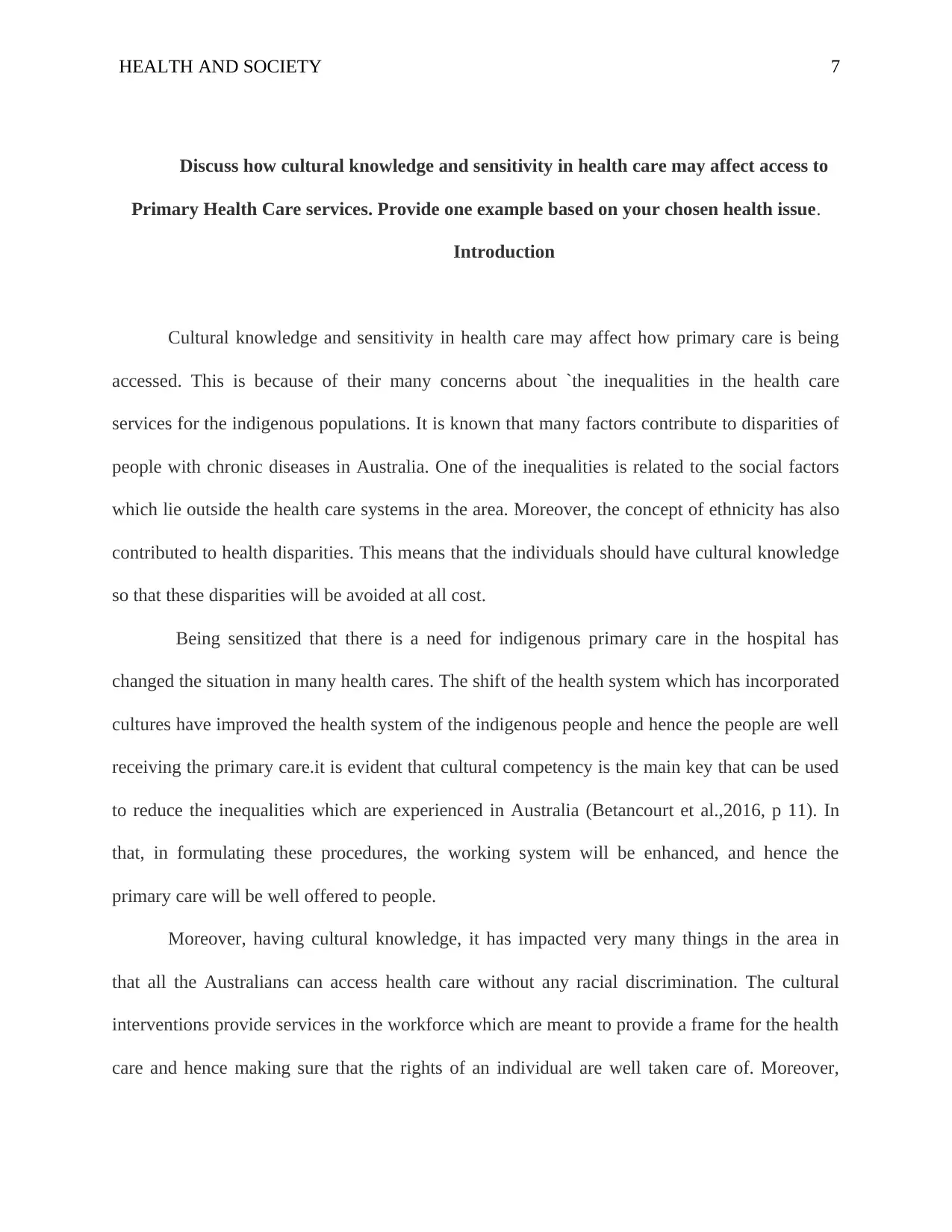
HEALTH AND SOCIETY 7
Discuss how cultural knowledge and sensitivity in health care may affect access to
Primary Health Care services. Provide one example based on your chosen health issue.
Introduction
Cultural knowledge and sensitivity in health care may affect how primary care is being
accessed. This is because of their many concerns about `the inequalities in the health care
services for the indigenous populations. It is known that many factors contribute to disparities of
people with chronic diseases in Australia. One of the inequalities is related to the social factors
which lie outside the health care systems in the area. Moreover, the concept of ethnicity has also
contributed to health disparities. This means that the individuals should have cultural knowledge
so that these disparities will be avoided at all cost.
Being sensitized that there is a need for indigenous primary care in the hospital has
changed the situation in many health cares. The shift of the health system which has incorporated
cultures have improved the health system of the indigenous people and hence the people are well
receiving the primary care.it is evident that cultural competency is the main key that can be used
to reduce the inequalities which are experienced in Australia (Betancourt et al.,2016, p 11). In
that, in formulating these procedures, the working system will be enhanced, and hence the
primary care will be well offered to people.
Moreover, having cultural knowledge, it has impacted very many things in the area in
that all the Australians can access health care without any racial discrimination. The cultural
interventions provide services in the workforce which are meant to provide a frame for the health
care and hence making sure that the rights of an individual are well taken care of. Moreover,
Discuss how cultural knowledge and sensitivity in health care may affect access to
Primary Health Care services. Provide one example based on your chosen health issue.
Introduction
Cultural knowledge and sensitivity in health care may affect how primary care is being
accessed. This is because of their many concerns about `the inequalities in the health care
services for the indigenous populations. It is known that many factors contribute to disparities of
people with chronic diseases in Australia. One of the inequalities is related to the social factors
which lie outside the health care systems in the area. Moreover, the concept of ethnicity has also
contributed to health disparities. This means that the individuals should have cultural knowledge
so that these disparities will be avoided at all cost.
Being sensitized that there is a need for indigenous primary care in the hospital has
changed the situation in many health cares. The shift of the health system which has incorporated
cultures have improved the health system of the indigenous people and hence the people are well
receiving the primary care.it is evident that cultural competency is the main key that can be used
to reduce the inequalities which are experienced in Australia (Betancourt et al.,2016, p 11). In
that, in formulating these procedures, the working system will be enhanced, and hence the
primary care will be well offered to people.
Moreover, having cultural knowledge, it has impacted very many things in the area in
that all the Australians can access health care without any racial discrimination. The cultural
interventions provide services in the workforce which are meant to provide a frame for the health
care and hence making sure that the rights of an individual are well taken care of. Moreover,
Paraphrase This Document
Need a fresh take? Get an instant paraphrase of this document with our AI Paraphraser
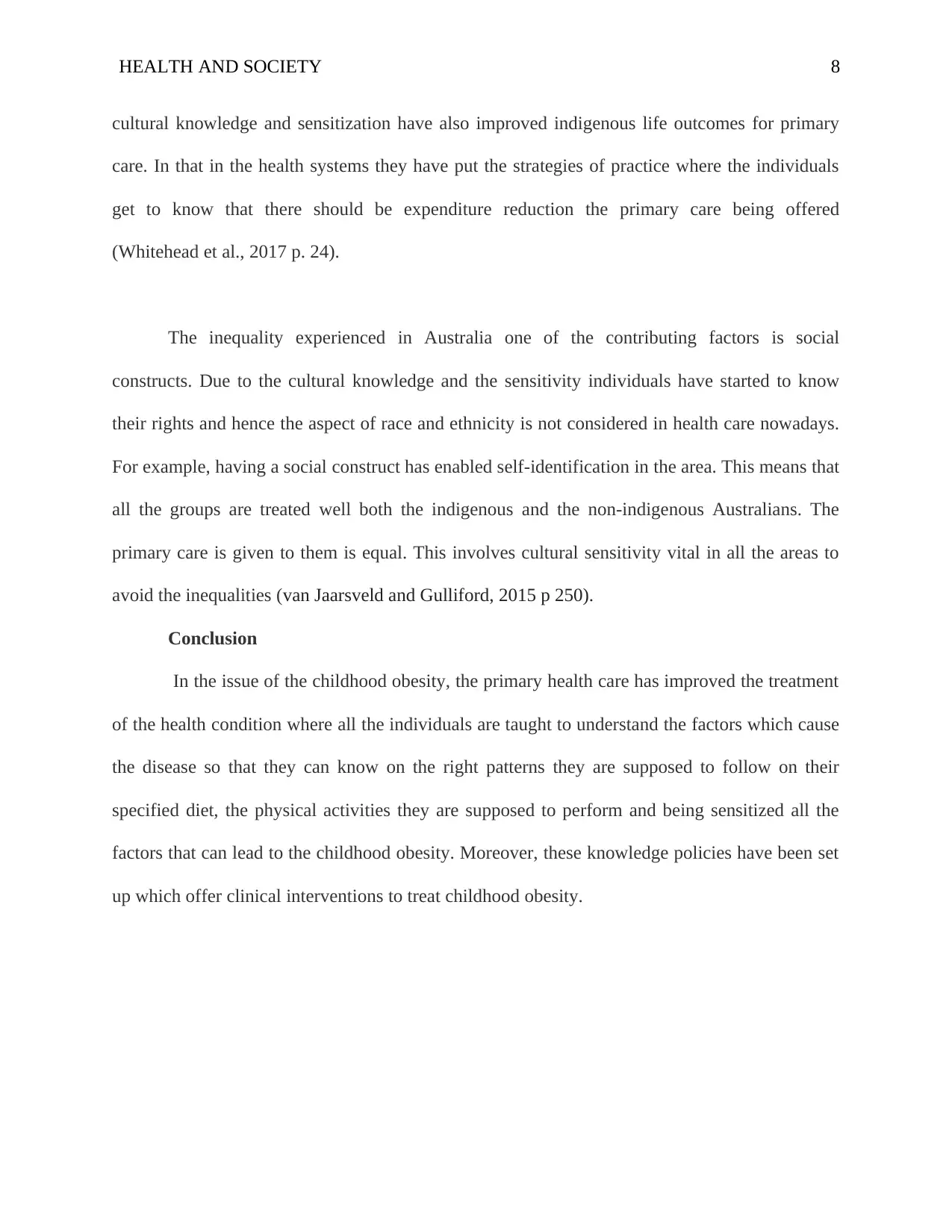
HEALTH AND SOCIETY 8
cultural knowledge and sensitization have also improved indigenous life outcomes for primary
care. In that in the health systems they have put the strategies of practice where the individuals
get to know that there should be expenditure reduction the primary care being offered
(Whitehead et al., 2017 p. 24).
The inequality experienced in Australia one of the contributing factors is social
constructs. Due to the cultural knowledge and the sensitivity individuals have started to know
their rights and hence the aspect of race and ethnicity is not considered in health care nowadays.
For example, having a social construct has enabled self-identification in the area. This means that
all the groups are treated well both the indigenous and the non-indigenous Australians. The
primary care is given to them is equal. This involves cultural sensitivity vital in all the areas to
avoid the inequalities (van Jaarsveld and Gulliford, 2015 p 250).
Conclusion
In the issue of the childhood obesity, the primary health care has improved the treatment
of the health condition where all the individuals are taught to understand the factors which cause
the disease so that they can know on the right patterns they are supposed to follow on their
specified diet, the physical activities they are supposed to perform and being sensitized all the
factors that can lead to the childhood obesity. Moreover, these knowledge policies have been set
up which offer clinical interventions to treat childhood obesity.
cultural knowledge and sensitization have also improved indigenous life outcomes for primary
care. In that in the health systems they have put the strategies of practice where the individuals
get to know that there should be expenditure reduction the primary care being offered
(Whitehead et al., 2017 p. 24).
The inequality experienced in Australia one of the contributing factors is social
constructs. Due to the cultural knowledge and the sensitivity individuals have started to know
their rights and hence the aspect of race and ethnicity is not considered in health care nowadays.
For example, having a social construct has enabled self-identification in the area. This means that
all the groups are treated well both the indigenous and the non-indigenous Australians. The
primary care is given to them is equal. This involves cultural sensitivity vital in all the areas to
avoid the inequalities (van Jaarsveld and Gulliford, 2015 p 250).
Conclusion
In the issue of the childhood obesity, the primary health care has improved the treatment
of the health condition where all the individuals are taught to understand the factors which cause
the disease so that they can know on the right patterns they are supposed to follow on their
specified diet, the physical activities they are supposed to perform and being sensitized all the
factors that can lead to the childhood obesity. Moreover, these knowledge policies have been set
up which offer clinical interventions to treat childhood obesity.
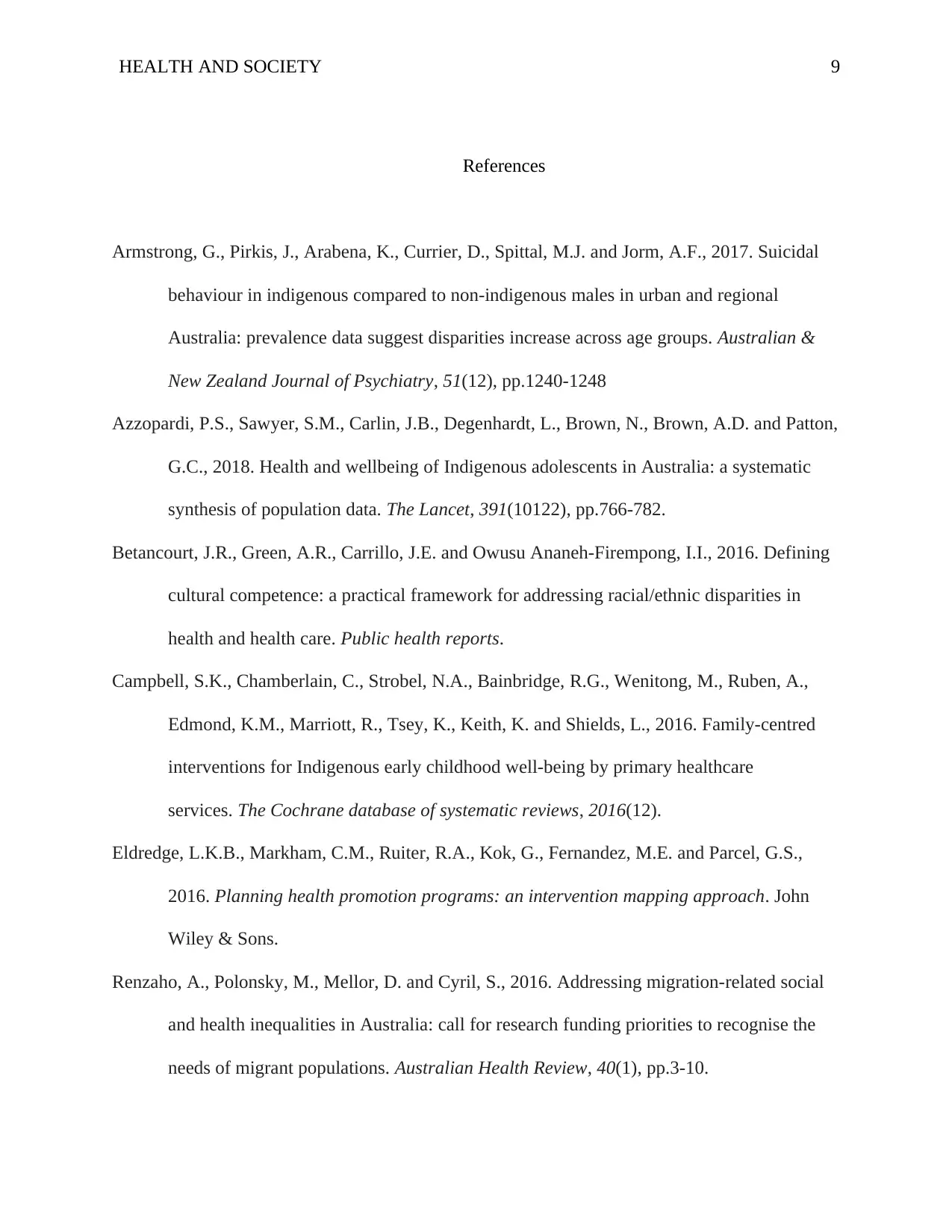
HEALTH AND SOCIETY 9
References
Armstrong, G., Pirkis, J., Arabena, K., Currier, D., Spittal, M.J. and Jorm, A.F., 2017. Suicidal
behaviour in indigenous compared to non-indigenous males in urban and regional
Australia: prevalence data suggest disparities increase across age groups. Australian &
New Zealand Journal of Psychiatry, 51(12), pp.1240-1248
Azzopardi, P.S., Sawyer, S.M., Carlin, J.B., Degenhardt, L., Brown, N., Brown, A.D. and Patton,
G.C., 2018. Health and wellbeing of Indigenous adolescents in Australia: a systematic
synthesis of population data. The Lancet, 391(10122), pp.766-782.
Betancourt, J.R., Green, A.R., Carrillo, J.E. and Owusu Ananeh-Firempong, I.I., 2016. Defining
cultural competence: a practical framework for addressing racial/ethnic disparities in
health and health care. Public health reports.
Campbell, S.K., Chamberlain, C., Strobel, N.A., Bainbridge, R.G., Wenitong, M., Ruben, A.,
Edmond, K.M., Marriott, R., Tsey, K., Keith, K. and Shields, L., 2016. Family‐centred
interventions for Indigenous early childhood well‐being by primary healthcare
services. The Cochrane database of systematic reviews, 2016(12).
Eldredge, L.K.B., Markham, C.M., Ruiter, R.A., Kok, G., Fernandez, M.E. and Parcel, G.S.,
2016. Planning health promotion programs: an intervention mapping approach. John
Wiley & Sons.
Renzaho, A., Polonsky, M., Mellor, D. and Cyril, S., 2016. Addressing migration-related social
and health inequalities in Australia: call for research funding priorities to recognise the
needs of migrant populations. Australian Health Review, 40(1), pp.3-10.
References
Armstrong, G., Pirkis, J., Arabena, K., Currier, D., Spittal, M.J. and Jorm, A.F., 2017. Suicidal
behaviour in indigenous compared to non-indigenous males in urban and regional
Australia: prevalence data suggest disparities increase across age groups. Australian &
New Zealand Journal of Psychiatry, 51(12), pp.1240-1248
Azzopardi, P.S., Sawyer, S.M., Carlin, J.B., Degenhardt, L., Brown, N., Brown, A.D. and Patton,
G.C., 2018. Health and wellbeing of Indigenous adolescents in Australia: a systematic
synthesis of population data. The Lancet, 391(10122), pp.766-782.
Betancourt, J.R., Green, A.R., Carrillo, J.E. and Owusu Ananeh-Firempong, I.I., 2016. Defining
cultural competence: a practical framework for addressing racial/ethnic disparities in
health and health care. Public health reports.
Campbell, S.K., Chamberlain, C., Strobel, N.A., Bainbridge, R.G., Wenitong, M., Ruben, A.,
Edmond, K.M., Marriott, R., Tsey, K., Keith, K. and Shields, L., 2016. Family‐centred
interventions for Indigenous early childhood well‐being by primary healthcare
services. The Cochrane database of systematic reviews, 2016(12).
Eldredge, L.K.B., Markham, C.M., Ruiter, R.A., Kok, G., Fernandez, M.E. and Parcel, G.S.,
2016. Planning health promotion programs: an intervention mapping approach. John
Wiley & Sons.
Renzaho, A., Polonsky, M., Mellor, D. and Cyril, S., 2016. Addressing migration-related social
and health inequalities in Australia: call for research funding priorities to recognise the
needs of migrant populations. Australian Health Review, 40(1), pp.3-10.
⊘ This is a preview!⊘
Do you want full access?
Subscribe today to unlock all pages.

Trusted by 1+ million students worldwide
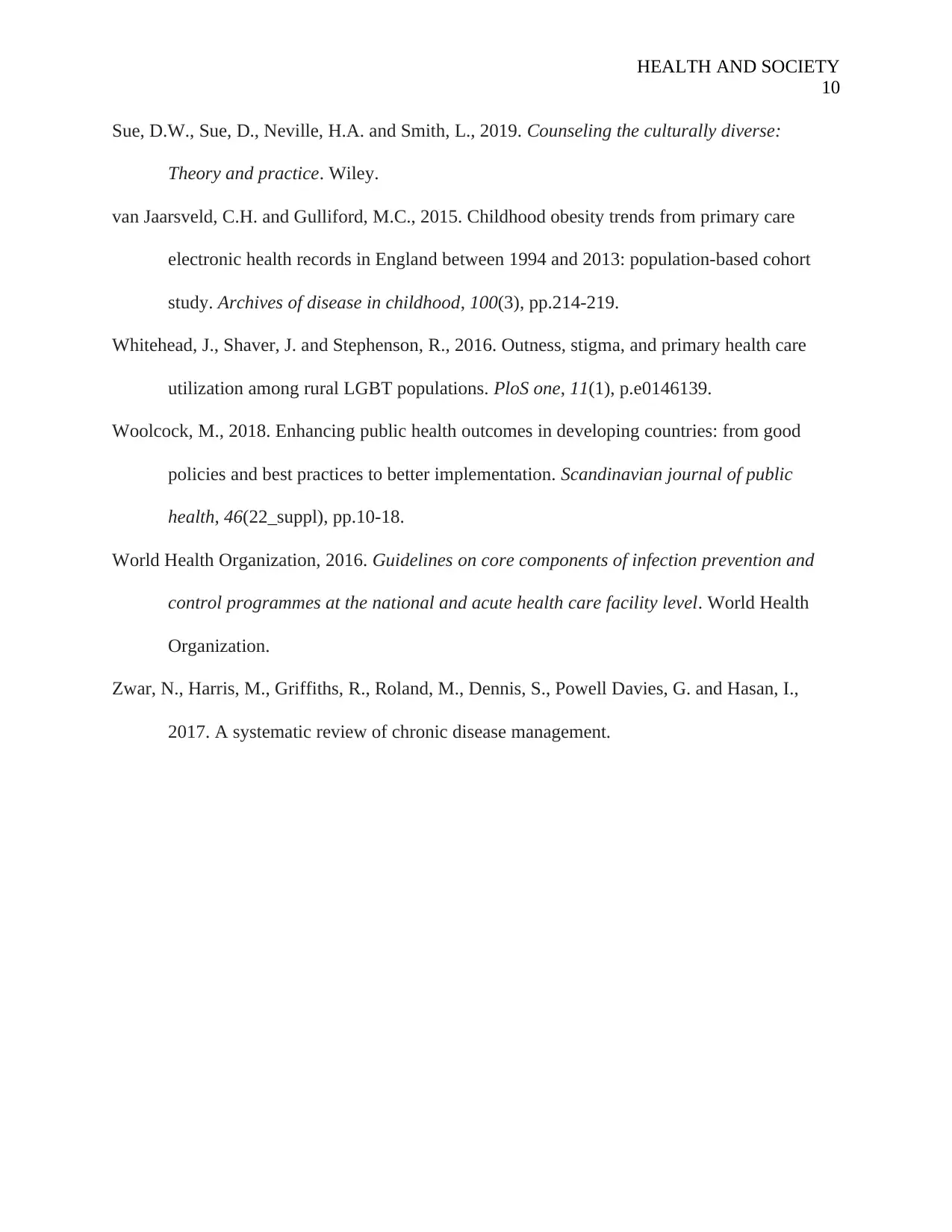
HEALTH AND SOCIETY
10
Sue, D.W., Sue, D., Neville, H.A. and Smith, L., 2019. Counseling the culturally diverse:
Theory and practice. Wiley.
van Jaarsveld, C.H. and Gulliford, M.C., 2015. Childhood obesity trends from primary care
electronic health records in England between 1994 and 2013: population-based cohort
study. Archives of disease in childhood, 100(3), pp.214-219.
Whitehead, J., Shaver, J. and Stephenson, R., 2016. Outness, stigma, and primary health care
utilization among rural LGBT populations. PloS one, 11(1), p.e0146139.
Woolcock, M., 2018. Enhancing public health outcomes in developing countries: from good
policies and best practices to better implementation. Scandinavian journal of public
health, 46(22_suppl), pp.10-18.
World Health Organization, 2016. Guidelines on core components of infection prevention and
control programmes at the national and acute health care facility level. World Health
Organization.
Zwar, N., Harris, M., Griffiths, R., Roland, M., Dennis, S., Powell Davies, G. and Hasan, I.,
2017. A systematic review of chronic disease management.
10
Sue, D.W., Sue, D., Neville, H.A. and Smith, L., 2019. Counseling the culturally diverse:
Theory and practice. Wiley.
van Jaarsveld, C.H. and Gulliford, M.C., 2015. Childhood obesity trends from primary care
electronic health records in England between 1994 and 2013: population-based cohort
study. Archives of disease in childhood, 100(3), pp.214-219.
Whitehead, J., Shaver, J. and Stephenson, R., 2016. Outness, stigma, and primary health care
utilization among rural LGBT populations. PloS one, 11(1), p.e0146139.
Woolcock, M., 2018. Enhancing public health outcomes in developing countries: from good
policies and best practices to better implementation. Scandinavian journal of public
health, 46(22_suppl), pp.10-18.
World Health Organization, 2016. Guidelines on core components of infection prevention and
control programmes at the national and acute health care facility level. World Health
Organization.
Zwar, N., Harris, M., Griffiths, R., Roland, M., Dennis, S., Powell Davies, G. and Hasan, I.,
2017. A systematic review of chronic disease management.
1 out of 10
Related Documents
Your All-in-One AI-Powered Toolkit for Academic Success.
+13062052269
info@desklib.com
Available 24*7 on WhatsApp / Email
![[object Object]](/_next/static/media/star-bottom.7253800d.svg)
Unlock your academic potential
Copyright © 2020–2025 A2Z Services. All Rights Reserved. Developed and managed by ZUCOL.





